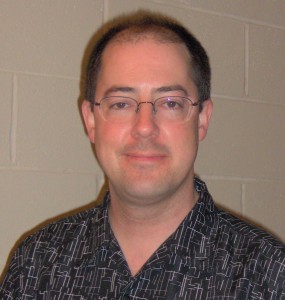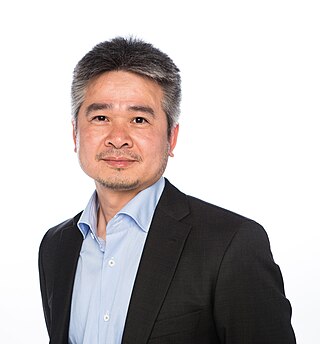
MEMS is the technology of microscopic devices incorporating both electronic and moving parts. MEMS are made up of components between 1 and 100 micrometres in size, and MEMS devices generally range in size from 20 micrometres to a millimetre, although components arranged in arrays can be more than 1000 mm2. They usually consist of a central unit that processes data and several components that interact with the surroundings.
Surface micromachining builds microstructures by deposition and etching structural layers over a substrate. This is different from Bulk micromachining, in which a silicon substrate wafer is selectively etched to produce structures.

Microfabrication is the process of fabricating miniature structures of micrometre scales and smaller. Historically, the earliest microfabrication processes were used for integrated circuit fabrication, also known as "semiconductor manufacturing" or "semiconductor device fabrication". In the last two decades, microelectromechanical systems (MEMS), microsystems, micromachines and their subfields have re-used, adapted or extended microfabrication methods. These subfields include microfluidics/lab-on-a-chip, optical MEMS, RF MEMS, PowerMEMS, BioMEMS and their extension into nanoscale. The production of flat-panel displays and solar cells also uses similar techniques.

A MEMS electrothermal actuator is a microelectromechanical device that typically generates motion by thermal expansion. It relies on the equilibrium between the thermal energy produced by an applied electric current and the heat dissipated into the environment or the substrate. Its working principle is based on resistive heating. Fabrication processes for electrothermal actuators include deep X-ray lithography, LIGA, and deep reactive ion etching (DRIE). These techniques allow for the creation of devices with high aspect ratios. Additionally, these actuators are relatively easy to fabricate and are compatible with standard Integrated Circuits (IC) and MEMS fabrication methods. These electrothermal actuators can be utilized in different kind of MEMS devices like microgrippers, micromirrors, tunable inductors and resonators.
Microoptoelectromechanical systems (MOEMS), also known as optical MEMS, are integrations of mechanical, optical, and electrical systems that involve sensing or manipulating optical signals at a very small size. MOEMS includes a wide variety of devices, for example optical switch, optical cross-connect, tunable VCSEL, microbolometers. These devices are usually fabricated using micro-optics and standard micromachining technologies using materials like silicon, silicon dioxide, silicon nitride and gallium arsenide.

Kristofer S. J. Pister is a professor of electrical engineering and computer sciences at University of California, Berkeley and the founder and CTO of Dust Networks. He is known for his academic work on Microelectromechanical systems (MEMS), their simulation, his work on Smartdust, and his membership in the JASON Defense Advisory Group. He is the son of former Berkeley Dean of Engineering and former UC Chancellor Karl Pister.

Mike A. Horton is an American engineer and founder of a company producing sensor technology and sensor-based systems.

Micropumps are devices that can control and manipulate small fluid volumes. Although any kind of small pump is often referred to as a micropump, a more accurate definition restricts this term to pumps with functional dimensions in the micrometer range. Such pumps are of special interest in microfluidic research, and have become available for industrial product integration in recent years. Their miniaturized overall size, potential cost and improved dosing accuracy compared to existing miniature pumps fuel the growing interest for this innovative kind of pump.

A MEMSmagnetic field sensor is a small-scale microelectromechanical systems (MEMS) device for detecting and measuring magnetic fields (magnetometer). Many of these operate by detecting effects of the Lorentz force: a change in voltage or resonant frequency may be measured electronically, or a mechanical displacement may be measured optically. Compensation for temperature effects is necessary. Its use as a miniaturized compass may be one such simple example application.
Mark G. Allen is a professor specializing in microfabrication, nanotechnology, and microelectromechanical systems at the University of Pennsylvania, where he is currently Alfred Fitler Moore Professor of Electrical and Systems Engineering Director of the Singh Center for Nanotechnology, and leader of the Microsensor and Microactuator Research Group. Prior to his joining the University of Pennsylvania in 2013, he was with the Georgia Institute of Technology, where he was Regents' Professor of Electrical and Computer Engineering and the J.M. Pettit Professor in Microelectronics. While at Georgia Tech, he also held multiple administrative positions, including Senior Vice Provost for Research and Innovation; Acting Director of the Georgia Electronic Design Center; and Inaugural Executive Director of Georgia Tech's Institute for Electronics and Nanotechnology. He was editor in chief of the Journal of Micromechanics and Microengineering (JMM), and currently serves on the editorial board of JMM as well as the journal Microsystems and Nanoengineering.
Microelectromechanical system oscillators are devices that generate highly stable reference frequencies used to sequence electronic systems, manage data transfer, define radio frequencies, and measure elapsed time. The core technologies used in MEMS oscillators have been in development since the mid-1960s, but have only been sufficiently advanced for commercial applications since 2006. MEMS oscillators incorporate MEMS resonators, which are microelectromechanical structures that define stable frequencies. MEMS clock generators are MEMS timing devices with multiple outputs for systems that need more than a single reference frequency. MEMS oscillators are a valid alternative to older, more established quartz crystal oscillators, offering better resilience against vibration and mechanical shock, and reliability with respect to temperature variation.

Richard Stephen Muller is an American professor in the Electrical Engineering and Computer Science Department of the University of California at Berkeley.
A nanoelectromechanical (NEM) relay is an electrically actuatedswitch that is built on the nanometer scale using semiconductor fabrication techniques. They are designed to operate in replacement of, or in conjunction with, traditional semiconductor logic. While the mechanical nature of NEM relays makes them switch much slower than solid-state relays, they have many advantageous properties, such as zero current leakage and low power consumption, which make them potentially useful in next generation computing.

Roger Thomas Howe is the William E. Ayer Professor of Electrical Engineering at Stanford University. He earned a B.S. degree in physics from Harvey Mudd College and M.S. and Ph.D. degrees in electrical engineering from the University of California, Berkeley in 1981 and 1984, respectively. He was a faculty member at Carnegie-Mellon University from 1984-1985, at the Massachusetts Institute of Technology from 1985-1987, and at UC Berkeley between 1987-2005, where he was the Robert S. Pepper Distinguished Professor. He has been a faculty member of the School of Engineering at Stanford since 2005.

Andrei M. Shkel is a Professor of Mechanical and Aerospace Engineering at the University of California, Irvine. He was named Fellow of the Institute of Electrical and Electronics Engineers (IEEE) in 2014 "for contributions to micromachined gyroscopes". He served as the President of the IEEE Sensors Council (2020-2021). In 2021, he was elected to National Academy of Inventors (NAI) Fellow status. He is currently the Editor-in-Chief of the IEEE Sensors Letters.
Srinivas Tadigadapa is a professor and chair of the Department of Electrical and Computer Engineering at Northeastern University in Boston, Massachusetts. From 2000 to 2017 he was a professor of electrical engineering at Penn State University. Prior to that, he was the vice president of manufacturing at Integrated Sensing Systems Inc., and was involved with the design, fabrication, packaging, reliability, and manufacturing of micromachined silicon pressure and Coriolis flow sensors.
A piezoelectric microelectromechanical system (piezoMEMS) is a miniature or microscopic device that uses piezoelectricity to generate motion and carry out its tasks. It is a microelectromechanical system that takes advantage of an electrical potential that appears under mechanical stress. PiezoMEMS can be found in a variety of applications, such as switches, inkjet printer heads, sensors, micropumps, and energy harvesters.
Vapor etching refers to a process used in the fabrication of Microelectromechanical systems (MEMS) and Nanoelectromechanical systems (NEMS). Sacrificial layers are isotropically etched using gaseous acids such as Hydrogen fluoride and Xenon difluoride to release the free standing components of the device.

Ha Duong Ngo is an academician, research scholar in the field of Electrical Engineering/Microsystems Engineering.
Pasqualina Maria (Lina) Sarro is an Italian nanoscientist whose research concerns micromachining and other techniques for fabricating silicon and silicon carbide based micro-electromechanical systems. She is professor of Electronic Components, Technology and Materials, former Antoni van Leeuwenhoek Professor, and former department chair, in the Department of Microelectronics of the Delft University of Technology in The Netherlands.









